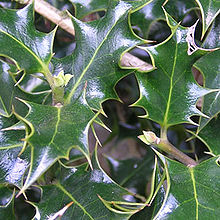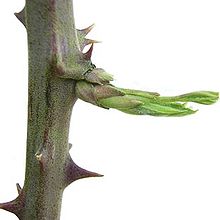
Gemmotherapy
Encyclopedia


Herbalism
Herbalism is a traditional medicinal or folk medicine practice based on the use of plants and plant extracts. Herbalism is also known as botanical medicine, medical herbalism, herbal medicine, herbology, herblore, and phytotherapy...
that uses remedies made principally from the embryonic tissue of various tree
Tree
A tree is a perennial woody plant. It is most often defined as a woody plant that has many secondary branches supported clear of the ground on a single main stem or trunk with clear apical dominance. A minimum height specification at maturity is cited by some authors, varying from 3 m to...
s and shrub
Shrub
A shrub or bush is distinguished from a tree by its multiple stems and shorter height, usually under 5–6 m tall. A large number of plants may become either shrubs or trees, depending on the growing conditions they experience...
s (the bud
Bud
In botany, a bud is an undeveloped or embryonic shoot and normally occurs in the axil of a leaf or at the tip of the stem. Once formed, a bud may remain for some time in a dormant condition, or it may form a shoot immediately. Buds may be specialized to develop flowers or short shoots, or may have...
s and emerging shoots), but also from the reproductive parts (the seed
Seed
A seed is a small embryonic plant enclosed in a covering called the seed coat, usually with some stored food. It is the product of the ripened ovule of gymnosperm and angiosperm plants which occurs after fertilization and some growth within the mother plant...
s and catkin
Catkin
A catkin or ament is a slim, cylindrical flower cluster, with inconspicuous or no petals, usually wind-pollinated but sometimes insect pollinated . They contain many, usually unisexual flowers, arranged closely along a central stem which is often drooping...
s) and from newly-grown tissue (the root
Root
In vascular plants, the root is the organ of a plant that typically lies below the surface of the soil. This is not always the case, however, since a root can also be aerial or aerating . Furthermore, a stem normally occurring below ground is not exceptional either...
lets and the cortex of rootlets). In two instances, remedies are also made from the sap
Plant sap
Sap is a fluid transported in xylem cells or phloem sieve tube elements of a plant. It transports water and nutrients throughout the plant....
.
This raw material is taken in the Spring (in the case of the seeds, in the Autumn), at the peak time of the tree or shrub’s annual germination
Germination
Germination is the process in which a plant or fungus emerges from a seed or spore, respectively, and begins growth. The most common example of germination is the sprouting of a seedling from a seed of an angiosperm or gymnosperm. However the growth of a sporeling from a spore, for example the...
, in order to capture the various nutrients, vitamins, plant hormones and enzymes that are released during this process, and which in some cases are only present in the plant at this time. Some practitioners of gemmotherapy (they are rarely referred to as ‘gemmotherapists’) furthermore believe that:
- the vital energyVitalismVitalism, as defined by the Merriam-Webster dictionary, is#a doctrine that the functions of a living organism are due to a vital principle distinct from biochemical reactions...
of trees and shrubs is at its highest point when the new leaves, branches and flowers begin to emerge - the vital energy is concentrated in these parts
- this energy in some way remains in or informs the resulting gemmotherapy remedies; and
- the efficacy of gemmotherapy remedies is enhanced or explained by it
Development and spread of gemmotherapy
The therapeutic effects of remedies made from the embryonic material of plants were first investigated in the late 1950s by a Belgian doctor, Pol Henry MD (1918-88), working with a group of French homeopaths and biotherapists including Max Tétau MD (1927-) and O.A. Julian MD. They conducted a series of clinical trials on humans and animals to establish the psychopharmacological effects of, initially, some twenty or so gemmotherapy remedies, and published several monographs detailing their findings (see for example refs 3-5 below).Gemmotherapy became an accepted form of herbal medicine in France (entering the Pharmacopée Francaise in 1965), but it is now most widely used in Italy. Until recently it has been virtually unknown outside these two countries, with the partial exception of the UK, the USA, Germany, Switzerland, Austria and the Czech Republic.
Use
Gemmotherapy remedies have principally been used for organ drainage in France, generally prior to homeopathic treatmentHomeopathy
Homeopathy is a form of alternative medicine in which practitioners claim to treat patients using highly diluted preparations that are believed to cause healthy people to exhibit symptoms that are similar to those exhibited by the patient...
. There, the primary role of herbal or naturopathic treatment
Naturopathic medicine
Naturopathy, or Naturopathic Medicine, is a form of alternative medicine based on a belief in vitalism, which posits that a special energy called vital energy or vital force guides bodily processes such as metabolism, reproduction, growth, and adaptation...
is considered to be the detoxification of tissues that have accumulated waste material due to the malfunction of the body’s eliminative processes, under pressure from environmental pollution, poor diet and the modern lifestyle. Gemmotherapy remedies are often used in mixtures or combinations, or together with herbal medicines and oligotherapy, in line with the ‘complex’ approach of complementary and alternative therapies (CAM)
Alternative medicine
Alternative medicine is any healing practice, "that does not fall within the realm of conventional medicine." It is based on historical or cultural traditions, rather than on scientific evidence....
in that country.
In Italy, where homeopathy and related therapies adhere to the more classical tradition of the ‘simplex’ (i.e. one remedy at a time), gemmotherapy remedies tend to be used in a different way. Although they continue to have an important role as drainage remedies, they are frequently also used either symptomatically or systemically as an adjunct to homeopathy and other therapeutic approaches, or indeed as a sole treatment in their own right. They are therefore as likely to be used in the treatment of sleeplessness or high blood pressure as for sinusitis or digestive problems.
Production

European Pharmacopoeia
The European Pharmacopoeia of the Council of Europe is a pharmacopoeia, listing a wide range of active substances and excipients used to prepare pharmaceutical products in Europe...
.
As soon as possible after being picked (and with a delay of not more than a few hours), the buds, young shoots or other parts to be used are cleaned and weighed. A sample is set aside so that the dry weight of the plant material can be determined. This is done by heating it at 105°C in an oven until its weight does not reduce any further.
The rest of the fresh plant material is macerated in an equal quantity of alcohol and vegetable glycerin, to a combined total weight of twenty times the equivalent amount of the dried sample. The proportion of fresh buds to excipient is about 1:9, and of young shoots, about 1:4.
The mixture is left to stand for one month in a cool, shaded environment, and is agitated at intervals. It is then decanted and filtered under constant pressure. After standing for a further forty-eight hours, it is filtered once more. The resulting liquid is known as the souche, or stock. It consists of equal parts of glycerin and alcohol, and 10-25% plant material, depending on the water content of the plant used.
To prepare the remedies in their final bottled form, one part of the souche is diluted with nine parts of a mixture of 50% glycerin, 30% alcohol and 20% water, and this is lightly succussed (shaken rather than struck) thirty times to bring it to the 1DH (1X or 1:10) homeopathic potency.
If properly stored in light-proof bottles and a cool, preferably dark, environment, the therapeutic qualities of gemmotherapy remedies do not diminish significantly over time. However, European regulations stipulate that they should be used within five years of the date on which the plant material from which they were made was picked.
One or two producers use modes of production at variance to that described in the European Pharmacopoeia; for example by diluting the remedies in the final stage to the 2DH homeopathic potency, or by not diluting them at all and offering them as ‘concentrated’ gemmotherapy remedies.
Literature
The founding work is Henry’s Bases Biologiques de la Gemmothérapie.Several exploratory monographs were published in French in the Archives Homéopatiques de la Normandie during the 1960s (see for example ), and in the Cahiers de Biothérapie and other journals of biotherapy and phytotherapy through the 1970s and 80s (see for example ).
From the 1980s onward, many introductory and self-help books on gemmotherapy became available in Italy (see for example ).
The most extensive and authoritative book to date on gemmotherapy is Compendio di Gemmoterapia Clinica, only available in Italian, by Fernando Piterà MD.
Some research has been published in English, for example in the Journal of Ethnopharmacology.
The most recent work on gemmotherapy available in English is "Gemmotherapy: The Science of Healing with Plant Stem Cells," by Roger Halfon, M.D. This is an English translation (by Jon E. Graham) of "La gemmotherapie ou l'embryotherapie vegetale: La sante par les bourgeons" published in 2005 in France by Editions Trajectoire. "Gemmotherapy: The Science of Healing with Plant Stem Cells" was published in 2010 in the United States and Canada by Healing Arts Press, One Park Street, Rochester, Vermont 05767.
The main work on gemmotherapy available in English is Gemmotherapy: A Clinical Guide, by Max Tétau MD. This is a translation, published in Canada, of his Nouvelles Cliniques de Gemmothérapie.

